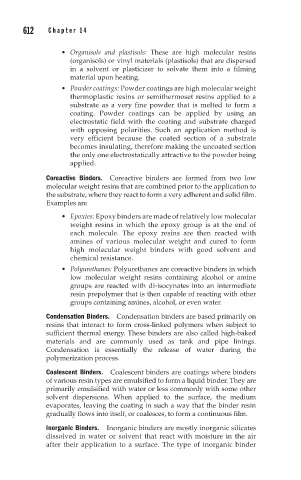Page 658 - Corrosion Engineering Principles and Practice
P. 658
612 C h a p t e r 1 4 P r o t e c t i v e C o a t i n g s 613
• Organisols and plastisols: These are high molecular resins
(organisols) or vinyl materials (plastisols) that are dispersed
in a solvent or plasticizer to solvate them into a filming
material upon heating.
• Powder coatings: Powder coatings are high molecular weight
thermoplastic resins or semithermoset resins applied to a
substrate as a very fine powder that is melted to form a
coating. Powder coatings can be applied by using an
electrostatic field with the coating and substrate charged
with opposing polarities. Such an application method is
very efficient because the coated section of a substrate
becomes insulating, therefore making the uncoated section
the only one electrostatically attractive to the powder being
applied.
Coreactive Binders. Coreactive binders are formed from two low
molecular weight resins that are combined prior to the application to
the substrate, where they react to form a very adherent and solid film.
Examples are
• Epoxies: Epoxy binders are made of relatively low molecular
weight resins in which the epoxy group is at the end of
each molecule. The epoxy resins are then reacted with
amines of various molecular weight and cured to form
high molecular weight binders with good solvent and
chemical resistance.
• Polyurethanes: Polyurethanes are coreactive binders in which
low molecular weight resins containing alcohol or amine
groups are reacted with di-isocynates into an intermediate
resin prepolymer that is then capable of reacting with other
groups containing amines, alcohol, or even water.
Condensation Binders. Condensation binders are based primarily on
resins that interact to form cross-linked polymers when subject to
sufficient thermal energy. These binders are also called high-baked
materials and are commonly used as tank and pipe linings.
Condensation is essentially the release of water during the
polymerization process.
Coalescent Binders. Coalescent binders are coatings where binders
of various resin types are emulsified to form a liquid binder. They are
primarily emulsified with water or less commonly with some other
solvent dispersions. When applied to the surface, the medium
evaporates, leaving the coating in such a way that the binder resin
gradually flows into itself, or coalesces, to form a continuous film.
Inorganic Binders. Inorganic binders are mostly inorganic silicates
dissolved in water or solvent that react with moisture in the air
after their application to a surface. The type of inorganic binder

